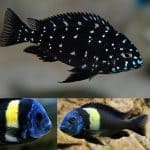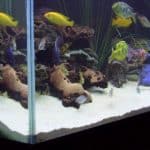
The cichlid food recipe you choose for your fish should be tailored to the type of cichlid you have. This is due to the different nutritional needs of cichlids. Herbivores prefer spirulina algae, which are high in vitamins and minerals and contain an easy-to-digest protein. This type of food is particularly beneficial for Mbuna and Tropheus species, which graze on algae throughout the day. Carnivores, on the other hand, require higher protein and animal food sources. Ideally, you should feed them a mix of animal and plant sources of food.
Contents
Adding gelatin to cichlid food
Adding gelatin to your cichlid’s food is a great way to increase the variety of nutrients in their diet. It’s also an excellent way to mix in various supplements and medications. Regardless of the species of cichlid you have, you can easily adjust their diet to match what they naturally eat in the wild. Start by mixing together two packets of unflavored gelatin. This should yield approximately 1 Tbsp of gelatin, which is equivalent to about 1/4 ounce or seven grams. You can also add leafy greens like spinach, which are high in vitamins and antioxidants. Lastly, you can add seaweed, which is a good source of minerals and nutrients.
Besides adding gelatin, you should also add other nutrients to your cichlid’s diet. For example, spirulina powder is a rich source of plant proteins. These nutrients are important for the health of your cichlid. Also, citrus fruits are very beneficial for your fish, and orange pulp and juice are excellent sources of vitamins and minerals. Garlic is also a great addition to fish diets, as it stimulates their appetite and helps prevent internal parasites.
Adding shrimp to cichlid food
Adding shrimp to your cichlid’s diet is a great way to give them a tasty and healthy treat. Shrimp is a great source of protein and color-enhancing nutrients and is a common treat for African cichlids. However, it is important to note that adding shrimp to your cichlid’s food should be done with caution and only on occasion.
Marine shrimp are available in a variety of colors and patterns. They are very effective cleaners and thrive in an aquarium populated by other fish and plants. The more fish and plants in your aquarium, the better for shrimp as they’ll have more food sources. Shrimp can also be fed flake food or algae pellets.
When adding shrimp to your cichlid food, you should always start with a small portion and monitor the consumption. Once the shrimp have eaten the food, increase the size of the portion the next time. Most keepers feed their colony once a day or every two or three days.
Feeding live food to cichlids
Live food for cichlids is a great way to give your fish a variety of nutrients. It is very protein-rich and can be expensive. But, it is not always easy to find. Many people choose to breed their own live food to feed their cichlids, but it requires a lot of effort and time. However, if you have the time, it can drastically cut down on your fish food bill. Cichlids can also be fed vegetables. Some species are herbivorous, while others are omnivorous.
Cichlids are generally not bottom feeders, so you must choose live food carefully. A live worm is not viable for a bottom feeder, but a frozen version is good for a mid-sized or large fish. Frozen bloodworms are another good option. You can also feed frozen brine shrimp to smaller cichlids, while bloodworms are best for medium-sized or large cichlids.
In the wild, Pike cichlids eat a variety of animal species. Their diet also includes algae and vegetable matter. Many aquarists feed their fish two to three different food species. This allows them to enjoy a variety of foods and helps prevent nutritional deficiencies. You can also supplement the diet with high-quality prepared food.
Avoiding ammonia in cichlid food
If you’re feeding your cichlids a commercial brand of cichlid food, you may want to avoid ammonia in your recipe. The ammonia in fish waste is converted into nitrite and nitrate by beneficial bacteria colonies. But you also need to avoid overfeeding your fish. Thankfully, there are ways to manage ammonia levels without harming your cichlids.
One way to avoid ammonia in cichlid food is to use shrimp. These little shrimps will provide a great source of protein without increasing your cichlids’ ammonia levels. The other option is to add cut fish to the tank.



